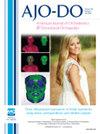Evaluation of nutrition changes during rapid maxillary expansion in adolescents
IF 3
2区 医学
Q1 DENTISTRY, ORAL SURGERY & MEDICINE
American Journal of Orthodontics and Dentofacial Orthopedics
Pub Date : 2025-05-01
DOI:10.1016/j.ajodo.2024.11.013
引用次数: 0
Abstract
Introduction
This study aimed to evaluate the nutritional changes in adolescents undergoing bonded rapid maxillary expansion (RME).
Methods
The study included 30 patients with maxillary posterior crossbite aged 12-16 years (21 girls and 9 boys) who were treated at the Department of Orthodontics, Faculty of Dentistry, Adıyaman University. Body weight (BW), body mass index (BMI), and 24-hour retrospective food consumption were recorded at 4 different time points (immediately before installation of the RME appliance [T1] and at the first [T2], fourth [T3], and 12th week of treatment [T4]).
Results
The energy, protein, fat, fiber, vitamin A, thiamine, riboflavin, vitamin B6, folate, vitamin E, and vitamin C levels at T1 were significantly higher than those at T2, T3, and T4, whereas the protein, carbohydrate, fiber, vitamin A, thiamine, riboflavin, vitamin B6, folate, vitamin E, and vitamin C levels at T2 were significantly lower than those at T1, T3, and T4 (P <0.05). BW and BMI at T1 were significantly higher than at T2 (mean decrease: BW, −1.71 ± 0.87; BMI, −0.70 ± 0.33) and T3 (mean decrease: BW, −1.09 ± 0.59; BMI, −0.55 ± 0.26; P <0.05).
Conclusions
Eating habits may change during RME.
青少年上颌快速扩张期间营养变化的评价。
简介:本研究旨在评估青少年颌突快速扩张(RME)后的营养变化。方法:选取Adıyaman大学牙科学院正畸科收治的上颌后牙合患者30例,年龄12 ~ 16岁,其中女生21例,男生9例。在4个不同时间点(RME矫形器安装前[T1]和治疗第1周[T2]、第4周[T3]和第12周[T4])记录体重(BW)、体重指数(BMI)和24小时回顾性摄食量。结果:T1时能量、蛋白质、脂肪、纤维、维生素A、硫胺素、核黄素、维生素B6、叶酸、维生素E和维生素C水平显著高于T2、T3和T4时,T2时蛋白质、碳水化合物、纤维、维生素A、硫胺素、核黄素、维生素B6、叶酸、维生素E和维生素C水平显著低于T1、T3和T4时(P结论:RME可能改变饮食习惯。
本文章由计算机程序翻译,如有差异,请以英文原文为准。
求助全文
约1分钟内获得全文
求助全文
来源期刊
CiteScore
4.80
自引率
13.30%
发文量
432
审稿时长
66 days
期刊介绍:
Published for more than 100 years, the American Journal of Orthodontics and Dentofacial Orthopedics remains the leading orthodontic resource. It is the official publication of the American Association of Orthodontists, its constituent societies, the American Board of Orthodontics, and the College of Diplomates of the American Board of Orthodontics. Each month its readers have access to original peer-reviewed articles that examine all phases of orthodontic treatment. Illustrated throughout, the publication includes tables, color photographs, and statistical data. Coverage includes successful diagnostic procedures, imaging techniques, bracket and archwire materials, extraction and impaction concerns, orthognathic surgery, TMJ disorders, removable appliances, and adult therapy.

 求助内容:
求助内容: 应助结果提醒方式:
应助结果提醒方式:


